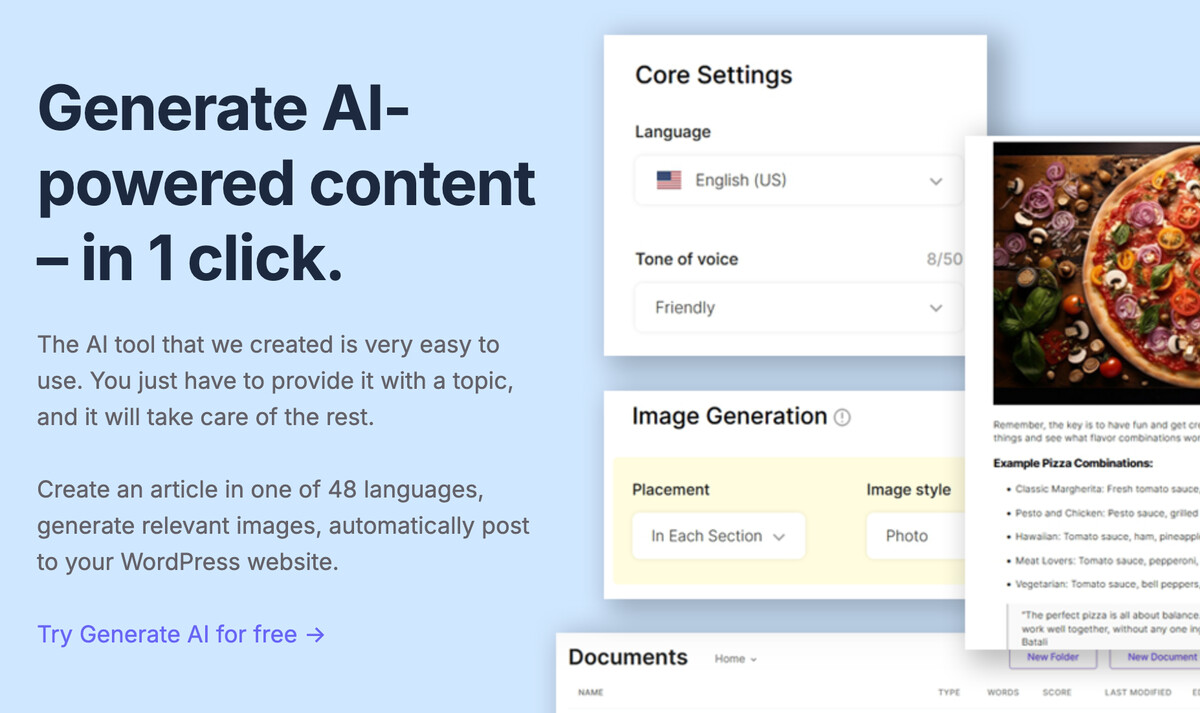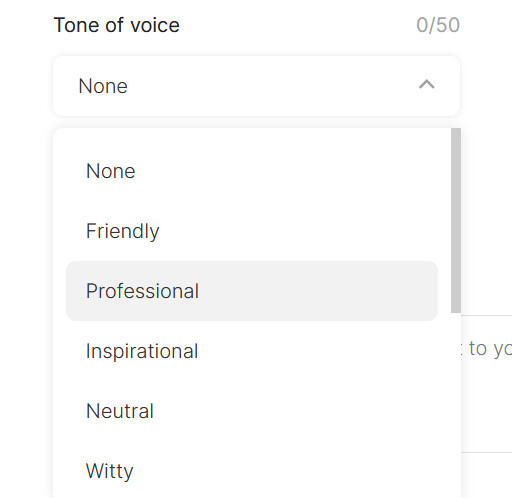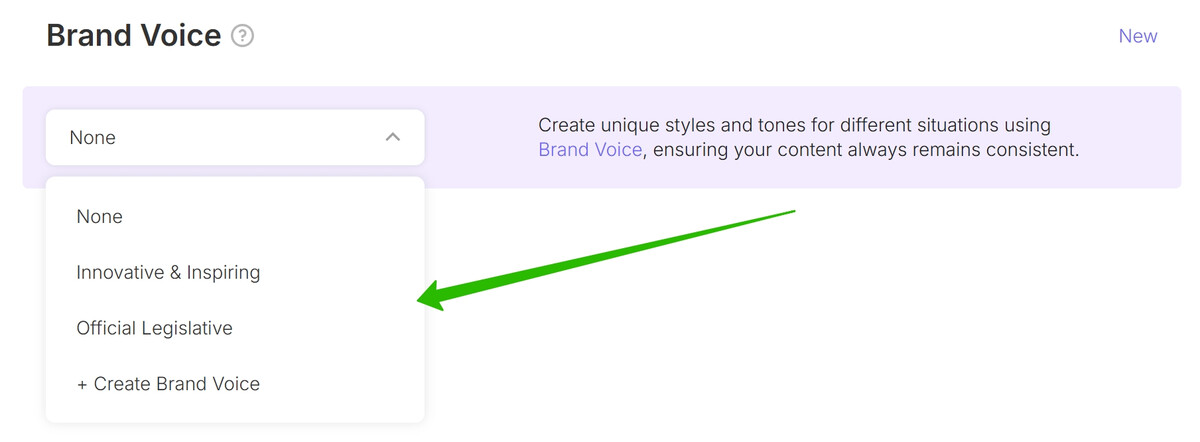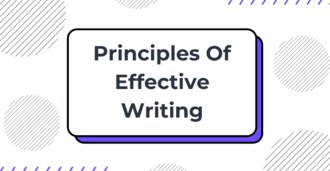Top 15 Types Of Tone In Writing (With Examples And Tips)

Have you ever read something that made you feel happy, sad, or even angry? That feeling comes from the tone of the writing. Tone shapes how readers connect with your content and affects whether they keep reading or click away.
Getting the tone right can make your writing more powerful and help you connect with readers. But using the wrong tone can confuse your audience or even push them away.
Learn about the most common types of writing tones, when to use each one, and effective tips to master them.
What Is Tone In Writing?
Tone in writing is the attitude you express toward your subject matter and readers. Think of it as the "voice" behind your words. Just like your voice changes when talking to different people in real life, your writing tone should change based on your purpose and audience.
Tone comes through in your word choice, sentence structure, and the details you choose to include or leave out. It can be formal or casual, serious or humorous, enthusiastic or matter-of-fact.
Why Does The Right Tone Matter?
The tone you choose affects how readers respond to your content:
-
It helps establish your credibility with the audience.
-
It keeps readers engaged with your content.
-
It makes your message clearer and more effective.
-
It helps you connect with readers on an emotional level.
-
It sets proper expectations for what follows.
Now let's look at the 15 most useful types of tone you can use in your writing.
15 Types Of Tone In Writing
1. Conversational Tone
Conversational tone feels like a friendly chat between you and the reader. It's relaxed, natural, and uses everyday language that flows easily.
When to use it: Blog posts, email newsletters, social media content, and most online content.
Example: "Have you tried that new coffee shop downtown? The one with the blue door? Their caramel latte is absolutely worth the extra dollar."
Tips for writing with conversational tone:
-
Write like you're talking to a friend sitting across from you.
-
Use contractions freely (don't, can't, you're) to sound more natural.
-
Ask questions throughout your content to engage readers directly.
-
Include personal experiences or anecdotes to connect with readers.
-
Use common expressions people actually say in real conversations.
2. Formal Tone
Formal tone maintains professional distance and follows conventional rules of writing. It uses proper grammar, avoids contractions and slang, and employs a more sophisticated vocabulary.
When to use it: Academic papers, business proposals, legal documents, job applications, and professional correspondence.
Example: "The research indicates a significant correlation between customer satisfaction and retention rates across all demographic segments."
Tips for writing with formal tone:
-
Eliminate contractions completely (write "do not" instead of "don't").
-
Avoid colloquialisms, idioms, and slang expressions.
-
Use third-person perspective rather than first or second person when possible.
-
Structure your writing with clear paragraphs and logical transitions.
-
Choose precise, technical vocabulary appropriate to your field.
3. Persuasive Tone
Persuasive tone aims to convince readers to agree with your position or take a specific action. It builds compelling arguments and appeals to both logic and emotion.
When to use it: Sales pages, marketing emails, opinion pieces, product reviews, and call-to-action content.
Example: "You've tried the ordinary solutions and seen ordinary results. Now discover what happens when you use the system specifically designed for your unique challenges."
Tips for writing with persuasive tone:
-
Start with a strong hook that addresses the reader's pain point directly.
-
Use concrete numbers and specific examples rather than general claims.
-
Include testimonials or case studies to build credibility and social proof.
-
Address potential objections before the reader can raise them.
-
End with a clear, specific call to action that tells readers exactly what to do next.
4. Instructional Tone
Instructional tone focuses on teaching readers how to do something clearly and effectively. It breaks down complex processes into manageable steps.
When to use it: How-to guides, tutorials, recipes, product manuals, and educational content.
Example: "Start by preheating your oven to 350°F. While it's heating, mix the dry ingredients in a large bowl, making sure to sift the flour first to prevent lumps."
Tips for writing with instructional tone:
-
Begin with a list of necessary materials or prerequisites.
-
Number your steps clearly and keep each step focused on a single action.
-
Use imperative verbs (stir, click, measure) to begin instructions.
-
Include troubleshooting tips for common mistakes or problems.
-
Add visuals where helpful to clarify complex steps.
5. Enthusiastic Tone
Enthusiastic tone expresses excitement, passion, and energy about your topic. It uses dynamic language to generate interest and engagement from readers.
When to use it: Product launches, event announcements, positive news, and content about topics you're genuinely excited about.
Example: "This new feature changes everything! You'll save hours every week and finally be able to focus on the creative work you actually enjoy."
Tips for writing with enthusiastic tone:
-
Use strong, vivid verbs that convey energy and action.
-
Incorporate genuine personal excitement rather than forced hype.
-
Highlight specific benefits that justify your enthusiasm.
-
Add appropriate exclamation points (but limit to one or two per paragraph).
-
Backup enthusiasm with concrete reasons why the reader should be excited too.
6. Inspirational Tone
Inspirational tone aims to motivate, uplift, and encourage readers. It creates positive emotions and inspires action through possibility and hope.
When to use it: Motivational articles, personal development content, mission statements, and coaching materials.
Example: "Every obstacle you face today is developing the strength you'll need for tomorrow. Your persistence now is creating the breakthrough waiting just around the corner."
Tips for writing with inspirational tone:
-
Share specific stories of transformation rather than generic platitudes.
-
Use powerful, vivid imagery that helps readers visualize success.
-
Balance optimism with reality—acknowledge difficulties while focusing on solutions.
-
Include direct calls to action that help readers take immediate steps.
-
Create rhythm through sentence variation and occasional short, impactful statements.
7. Humorous Tone
Humorous tone aims to entertain and amuse readers. It uses wit, unexpected connections, or exaggeration to create enjoyment alongside information.
When to use it: Entertainment blogs, certain social media content, email newsletters, and brands with a fun personality.
Example: "I tried meditation once. Five minutes in, my 'clear mind' had planned an entire vacation, solved a work problem, and reminded me I needed to buy cat food."
Tips for writing with humorous tone:
-
Know exactly who you're writing for—humor is highly subjective.
-
Use specific, relatable situations rather than generic jokes.
-
Use the "rule of three" with the third item being unexpected.
-
Test your content with someone from your target audience before publishing.
-
Balance humor with substance—don't sacrifice clarity for comedy.
8. Informative Tone
Informative tone focuses on delivering facts, data, and information clearly and objectively. It prioritizes accuracy and clarity over style or emotion.
When to use it: News articles, reference materials, educational content, and informational pages.
Example: "The average adult requires between 7-9 hours of sleep per night, with sleep quality being as important as quantity for cognitive function and physical health."
Tips for writing with informative tone:
-
Begin with the most important information first (inverted pyramid style).
-
Include specific facts, statistics, and expert quotes to support your points.
-
Organize information into clear categories with descriptive subheadings.
-
Define technical terms when first introduced.
-
Use bullet points or numbered lists to break up dense information.
9. Informal Tone
Informal tone is relaxed, personal, and conversational. It uses everyday language, colloquialisms, and a friendly approach that feels approachable and casual.
When to use it: Personal blogs, social media posts, casual emails, and content targeting younger audiences.
Example: "So, I tried that new workout app last week, and wow—my muscles are still mad at me! But seriously, it's pretty great once you get past the initial shock."
Tips for writing with informal tone:
-
Use contractions liberally (I'm, you'll, can't, don't) to sound natural.
-
Include personal stories and first-person perspective when relevant.
-
Incorporate casual expressions and everyday vocabulary people actually use.
-
Feel free to bend grammar rules occasionally (starting sentences with "And" or "But").
-
Add personality through occasional slang or colloquialisms that fit your audience.
10. Sympathetic Tone
Sympathetic tone shows understanding and compassion for the reader's challenges or situation. It creates connection through empathy and validation.
When to use it: Support content, response to customer problems, health-related articles, and content addressing struggles.
Example: "Living with chronic pain changes everything about your daily life. Simple tasks become major hurdles, and the constant discomfort affects not just your body but your mood and relationships too."
Tips for writing with sympathetic tone:
-
Acknowledge specific difficulties rather than making general statements.
-
Use phrases that validate experiences ("It makes sense that you feel...").
-
Balance sympathy with practical help rather than dwelling only on problems.
-
Avoid toxic positivity that dismisses genuine challenges.
-
Include hopeful elements without minimizing the reality of tough situations.
11. Critical Tone
Critical tone evaluates a subject based on careful analysis. It points out both strengths and weaknesses based on specific criteria.
When to use it: Product reviews, literary analysis, performance evaluations, and analytical pieces.
Example: "While the camera excels in low-light conditions and offers impressive zoom capabilities, its unintuitive menu system requires a steep learning curve that may frustrate beginners."
Tips for writing with critical tone:
-
Start with a "criteria sandwich" - mention your evaluation standards, then the analysis, then refer back to your criteria.
-
Use the "positive-negative-solution" pattern for each major point you critique.
-
Replace general adjectives ("bad," "good") with specific descriptors ("unresponsive," "intuitive").
-
Mention who would be most and least satisfied with what you're evaluating.
-
Create a clear rating system that allows for nuance (not just "thumbs up/down").
12. Cautionary Tone
Cautionary tone warns readers about potential problems, risks, or consequences. It raises awareness of issues that require attention or concern.
When to use it: Safety instructions, risk assessments, health warnings, and content about potential problems.
Example: "Before starting any new medication, consult your doctor about possible interactions with your current prescriptions. Even common supplements can cause dangerous reactions when combined improperly."
Tips for writing with cautionary tone:
-
Clearly state the specific risk or concern early in the content.
-
Explain the potential consequences in concrete terms.
-
Provide actionable steps to avoid or mitigate the risk.
-
Use firm language without resorting to fear-mongering.
-
Include credible sources or evidence for your warnings.
13. Curious Tone
Curious tone shows interest in exploring ideas and asks thoughtful questions. It invites readers to join in discovery rather than presenting final answers.
When to use it: Thought leadership articles, philosophical discussions, brainstorming content, and exploration of emerging trends.
Example: "What if our understanding of productivity has been backward all along? What would happen if we measured output by impact rather than hours?"
Tips for writing with curious tone:
-
Ask genuine, thought-provoking questions throughout your content.
-
Present multiple perspectives rather than a single viewpoint.
-
Use phrases that signal openness ("I wonder," "Perhaps," "What if").
-
Invite reader participation and feedback explicitly.
-
Balance questioning with enough substance to make the exploration worthwhile.
14. Urgent Tone
Urgent tone creates a sense of immediacy and importance. It emphasizes time sensitivity and prompts quick action.
When to use it: Limited-time offers, breaking news, deadline-driven content, and emergency communications.
Example: "Registration closes at midnight tonight. With only 50 spots remaining and hundreds viewing this page, secure your place now before it's too late."
Tips for writing with urgent tone:
-
Specify exact deadlines or limitations (dates, times, quantities).
-
Use short sentences and paragraphs to increase reading speed.
-
Include time-sensitive language ("now," "today," "immediately").
-
Explain specific consequences of delay or inaction.
-
Repeat the call to action with increasing urgency throughout the content.
15. Joyful Tone
Joyful tone expresses happiness, celebration, and positive excitement. It creates an uplifting feeling and shares enthusiasm with readers.
When to use it: Announcement of good news, celebration posts, positive brand stories, and content about achievements.
Example: "We're thrilled to announce that our community has raised over $50,000 for local schools—double our initial goal! Your incredible generosity will fund art programs for 15 schools this year."
Tips for writing with joyful tone:
-
Use vibrant, positive words that express genuine enthusiasm.
-
Share specific details about what makes the situation exciting.
-
Include exclamation points sparingly but effectively.
-
Tell stories about positive impact or happy outcomes.
-
Invite readers to share in the celebration through engagement or participation.
How To Choose The Right Tone For Your Writing
Selecting the right tone makes your writing more effective. Here's how to choose the best tone for your content:
Know Your Audience
The most important factor in choosing your tone is understanding who will read your content:
-
What's their knowledge level on the topic?
-
What's their relationship to you or your brand?
-
What are their expectations when reading your content?
-
What tone would resonate with them best?
For example, writing for industry experts allows more technical language and formal tone, while general audiences usually prefer conversational, accessible content.
Consider Your Purpose
What do you want to achieve with your writing?
-
To inform or educate - informative, instructional, or curious tones work well.
-
To persuade or sell - persuasive, urgent, or enthusiastic tones are effective.
-
To entertain - humorous, joyful, or conversational tones can engage readers.
-
To provide support - sympathetic, inspirational, or helpful tones show care.
Match The Content Type
Different content formats have established tone expectations:
| Content Type | Most Effective Tones |
|---|---|
| Blog posts | Conversational, Informative, Curious |
| Sales pages | Persuasive, Urgent, Enthusiastic |
| Tutorials | Instructional, Conversational, Informative |
| Email newsletters | Conversational, Joyful, Persuasive |
| Case studies | Informative, Critical, Formal |
| Support content | Sympathetic, Instructional, Cautionary |
How To Edit Your Writing For Tone
Here's how to refine your tone during editing:
1. Read Your Content Aloud
Reading your writing out loud helps you hear its tone more clearly. Notice where it sounds off or doesn't flow naturally.
2. Check Your Word Choice
Words carry emotional weight and meaning. Review your vocabulary with these specific questions:
-
Are you using unnecessarily complex words when simple ones would work better?
-
Have you chosen words with unintended negative or positive associations?
-
Do your verbs convey the right level of energy or action?
-
Are your adjectives and adverbs sending the right emotional signals?
For example, consider these word choices and their tonal impact:
-
"Issue" vs. "problem" vs. "crisis" (increasing negativity)
-
"Talked about" vs. "discussed" vs. "debated" (increasing formality)
-
"Happy" vs. "delighted" vs. "ecstatic" (increasing intensity)
3. Look For Consistency
Tone shifts can confuse readers. Check if your tone stays consistent by:
-
Highlighting any sentences that feel different from your main tone.
-
Checking the beginning and end of your content match in tone.
-
Ensuring your title and headings match the tone of your main content.
How SEOWriting Helps Perfect Your Content Tone

SEOWriting offers specialized features to help you nail the perfect tone every time:
Its custom Tone of Voice selector lets you choose from multiple predefined tones like professional, inspirational, neutral, or witty. This means you can quickly adjust your content's emotional feel without manually editing every sentence.

For example, you might use:
-
Professional tone for industry reports
-
Inspirational tone for motivational content
-
Witty tone for entertainment-focused blog posts
-
Neutral tone for educational content
The Brand Voice Customizer takes tone control even further. Instead of starting from scratch with each piece, you can create a custom voice profile based on your existing content. Simply upload samples of writing that match your desired style, and SEOWriting will analyze the patterns to replicate that tone in future content.

This feature ensures consistency across all your content. The tool identifies the patterns in your best writing, from sentence structure to word choice, and applies them consistently to new content.
For content creators who struggle with tone consistency, these features save hours of editing time while producing more effective content that truly resonates with readers.
Final Thoughts
Mastering different types of tone gives you a powerful tool to connect with readers and make your content more effective. The right tone transforms good writing into great writing that resonates with your audience and achieves your communication goals.
Remember that tone isn't about following rigid rules—it's about making thoughtful choices that serve your specific purpose. Start by understanding your audience and objectives, then select the tone that best helps you connect with readers and convey your message. With practice, you'll develop an intuitive sense for which tones work best in different situations.
Ready to create content with the right type of tone? Get started with SEOWriting for free and start writing high-quality blog posts.



Write 10X Faster With AI-Powered Content
Create SEO-optimized articles in 15 minutes instead of 5 hours. Join 50,000+ content creators who generate content that ranks on top positions on Google. Save up to 80% of your time while getting 2X better results.
Try for Free →
